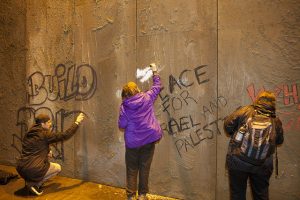 The WALL installation in the courtyard of St James’s Piccadilly is a life-size replica section of the 8 metre high Separation Wall that surrounds Bethlehem. Free to visit and open whenever the church is open throughout the festival, we invite you to write a prayer from any faith tradition, a poem, a reflection, an image or signature on the Wall itself.* The WALL projection programme includes specially commissioned animated images, paintings by children from the Dar Al-Kalima School in Bethlehem, One World’s song ‘Freedom for Palestine’ and video art pieces from internationally recognised Palestinian artist Larissa Sansour, ‘Happy Days’ and ‘A Space Exodus’.
The WALL installation in the courtyard of St James’s Piccadilly is a life-size replica section of the 8 metre high Separation Wall that surrounds Bethlehem. Free to visit and open whenever the church is open throughout the festival, we invite you to write a prayer from any faith tradition, a poem, a reflection, an image or signature on the Wall itself.* The WALL projection programme includes specially commissioned animated images, paintings by children from the Dar Al-Kalima School in Bethlehem, One World’s song ‘Freedom for Palestine’ and video art pieces from internationally recognised Palestinian artist Larissa Sansour, ‘Happy Days’ and ‘A Space Exodus’.
Bethlehem Unwrapped is a response to the 2009 KairosPalestine call from the united churches of the Holy Land. It asked churches and communities around the world, “Are you able to help us get our freedom back?” The festival is inspired by the cultural movement in Bethlehem known as ‘Beautiful Resistance’ in which Palestinians express their determination peacefully and creatively to resist injustice. In this spirit, the festival celebrates the culture and stories of those living behind the Wall, and the installation was commissioned and created in this spirit.
*The artist reserves the right to curate the installation.
The real WALL
In 2002, the government began building what was described as a Security Fence in occupied Palestinian Territory. The stated purpose was the security of Israeli citizens. In 2004, the International Court of Justice at The Hague declared the Barrier illegal under international law and called on Israel to dismantle the walls, return confiscated land and make reparations for damages.The Wall is called variously the Separation Barrier, the Security Barrier and the Wall, and stretches 708 km, the distance between London and Zurich. It is twice the length of Israel’s ‘green line’ border, agreed in 1949. 85% percent of the wall will not be built along Israel’s internationally recognized pre-1967 borders. Along its length the Barrier consists of fences, ditches, razor wire, groomed sand paths, an electronic monitoring system patrol roads and a buffer zone. Approximately 61 km of the constructed Barrier consists of 8-9 metre high concrete slab segments which are connected to form a wall, particularly in urban areas such as Jerusalem, Bethlehem, Qalqiliya and Tulkarm. Land obtained for construction of the Barrier is requisitioned from Palestinian landowners by the Israeli Ministry of Defence through military orders. Most orders are valid for three years and are renewable. (Source: UN Office for the Coordination of Humanitarian Affairs July 2011)

